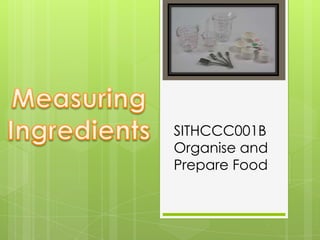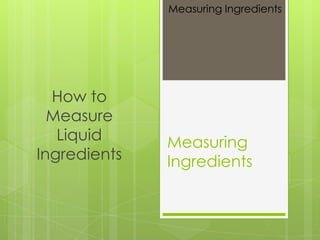Measuring Ingredients
- 2. Measuring IngredientsIntroductionTo produce quality cooked and baked products, it is important to measure ingredients accurately.
- 3. EquipmentChoosing the correct measuring equipment is vital in making accurate measurements.Different measuring equipment is selected depending upon the types and amounts of ingredients that will be measured.Measuring Ingredients
- 4. EquipmentMeasuring IngredientsDry ingredients, such as flour and sugar, are measured in plastic or metal measuring cups
- 5. EquipmentMeasuring IngredientsDry measuring cups are designed to overflow, then level the ingredient off with a straight-edged utensil.
- 6. EquipmentMeasuring IngredientsLiquids are measured in transparent glass or translucent plastic measuring jugs.
- 7. EquipmentMeasuring IngredientsLiquid measuring cups have a spout for pouring and have space between the top and the rim of the cup so that liquids do not spill while transferring.
- 8. EquipmentMeasuring IngredientsSmall amounts of ingredients are measured using plastic or metal measuring spoons.Dry and liquid ingredients, including fats may be measured using measuring spoons
- 9. EquipmentMeasuring IngredientsMeasuring equipment may provide:Metric measures, Imperial measures, orBoth.
- 10. Measuring IngredientsHow to Measure Dry IngredientsMeasuringIngredients
- 11. How to Measure Dry Ingredients: FlourSpoon the flour into the dry measuring cup, filling to overflowingLevel the flour off by dragging a straight-edged utensil across the top of the measuring cup.Measuring Ingredients
- 12. How to Measure Dry Ingredients:Granulated SugarMeasure granulated (white) sugar using the same method as is used for measuring flour.Measuring Ingredients
- 13. How to Measure Dry Ingredients: Brown SugarMeasuring IngredientsBrown sugar should be firmly packed into the dry measuring cup.You will know if it is packed correctly, when the sugar holds its shape when emptied.
- 14. How to Measure Dry Ingredients: Small AmountsMeasuring IngredientsWhen small amounts of a dry ingredient, such as flour, sugar, baking powder, baking soda, salt and spices, are to be measured, measuring spoons are utilized.Overfill the measuring spoon and level of the dry ingredient with a straight-edged utensil.
- 15. Measuring IngredientsHow to Measure Liquid IngredientsMeasuringIngredients
- 16. How to Measure Liquid IngredientsMeasuring IngredientsPlace measuring cup on a level surface when measuring liquid ingredientsAvoid lifting the cup to read the measure as this will result in an inaccurate amount
- 17. How to Measure Liquid IngredientsOnce the measuring cup is on a level surface, add the liquid you wish to measure.Read the level of the liquid by bending down to eye level.Measuring Ingredients
- 18. How to Measure Liquid Ingredients: Small AmountsSmall amounts of liquid ingredients may be measured using measuring spoons.Measuring Ingredients
- 19. How to Measure Fats: OilOil is measured using the method for measuring liquid ingredientsMeasuring Ingredients
- 20. How to Measure Fats: Solid FatsSolid fats including butter, margarine, lard and shortening.Several methods can be used when measuring solid fats, however depends on the kind of fat and the quantity.Measuring Ingredients
- 21. How to Measure Fats: Soft Solid FatsSoft fats, such as margarine and soft butter can be pressed into a dry measure and levelled off with a straight-edge utensil. Measuring Ingredients
- 22. How to measure Fats:Firm Solid FatsFirm fats, such as butter may be cut from the block, using the measurements provided on the packaging.Measuring Ingredients
- 23. ConclusionAccurate ingredient measurement is an important part of creating a quality floor product.With practice, every cook can develop accurate measuring skills. Measuring Ingredients






















